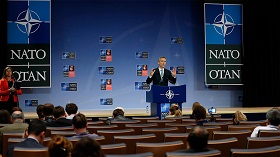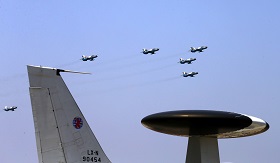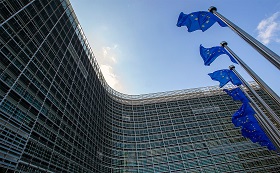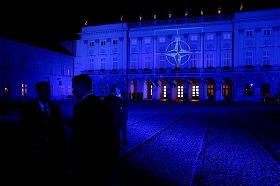Russia and NATO: a New Normal?
Norwegian Air Force's F-16 fighters (R) and
Italian Air Force's Eurofighter Typhoon fighters
patrol over the Baltics during a NATO air policing
mission from Zokniai air base near Siauliai,
Lithuania, May 20, 2015
(no votes) |
(0 votes) |
PhD in Political Science, Director General of the Russian International Affairs Council, RIAC member
Due to the Ukraine crisis, relations between Russia and NATO are definitely at a nadir for the entire period since the end of the Cold War. Their deterioration has been abrupt, snowballing and irreversible. Moscow's official documents also define NATO and its possible expansion as a key challenge, while the modernization of the Russian forces is primarily designed to counter the potential of its member-states.
Due to the Ukraine crisis, relations between Russia and NATO are definitely at a nadir for the entire period since the end of the Cold War. Their deterioration has been abrupt, snowballing and irreversible. As a matter of fact, Brussels regards Moscow as its top security challenge and at a minimum has made Russia an issue in the final communiqué of its Warsaw summit. In comparison with its other strategies including those for the Middle East and terrorism, the alliance has developed a most detailed Russia policy that comprises plans and specific measures to be taken in various situations. Moscow's official documents also define NATO and its possible expansion as a key challenge, while the modernization of the Russian forces is primarily designed to counter the potential of its member-states.
As of now, one might describe the condition of Russia-NATO relationship in medical terms as stably grave. The acute phase, which makes it impossible to predict outcomes and the depth of the crisis, appears over. But the crisis has so far failed to settle even one underlying problem. Moreover, things are getting worse, implying that further aggravation and the deeper escalation of the conflict are likely.
A situation like this would have hardly seemed strange 30 years ago, when the two blocs were entangled in an all-out ideological and military race. However, the world has radically changed. Both Russia and NATO are facing increasingly dangerous emerging challenges and threats. However, instead on focusing on current and future menaces, the two parties appear to be reproducing Cold War logic with a lose-lose outcome. In addition, the losses are far from calculable, as they may either remain within current limits or grow considerably if more crises emerge. To this end, quite important seem answers to the following questions: Why are Russia and NATO again becoming competitors? What are the drivers of the Russia-NATO relationship and the factors affecting its essence? What is to be done to make the relations more constructive?
Instead on focusing on current and future menaces, the two parties appear to be reproducing Cold War logic with a lose-lose outcome.
Nevertheless, before attempting to provide answers, we should spell out our basic approach, i.e. the conception of an appropriate status of security in Europe, which boils down to the notion that neither Russia nor NATO needs an armed conflict with potentially dreadful consequences. Today the two sides work to prevent the calamity through mutual containment, but in the long run this standpoint provides for a no-win scenario. First, containment is fraught with competition growing into a full-scale conflict. Second, it requires huge resources that should be channeled towards handling more dangerous challenges, more specifically radical Islamism. Hence, we should find a formula that would rid both sides as minimum of the need to restrain their counterpart. As a maximum, the formula should revive chances for cooperation. This is an extremely intricate political goal that now might seem utopian, but shedding this goal would bring enormous costs and maintain high security risks.
The Russia-NATO Crisis Pathway
The abovementioned basic approach hardly seems innovative. Skeptics would certainly highlight there has recently been an attempt to supplant containment by cooperation. But this was a huge flop symbolized by the Ukraine crisis that is seen by many as the main catalyst of the aggravating European environment. Indeed, the Ukrainian mess has become a powerful trigger that has brought the Russia-NATO relationship into a different state. However, this conundrum seems rather a consequence than the cause. Disagreements have been accumulating at least since the late 1990s, gradually getting worse each year and producing the Ukrainian eruption and a spasmodic situation change. Hence, what to be done is to identify the defects of the bilateral relationship which have caused the current status of affairs.
The most obvious reason quite naturally lies in the eastward expansion of NATO. Russia has been definitely wary about the process since its very onset and has seen it as killing the idea of equal and indivisible security, a violation of the balance of forces and a threat to Russia's security. NATO invariably countered the charges with the right of countries to be independent in joining alliances, especially as was specified by the Russia-NATO Founding Act in 1997. The discussion of the matter between Moscow and Brussels was increasingly similar to a deaf-and-dumb talk. Russia was sufficiently lenient about the entry of former Warsaw Pact and Baltic states but became visibly more irritated when it concerned encroaching on the post-Soviet space. Although the membership of Ukraine and other countries of the ex-USSR appeared extremely questionable and was seen by the alliance in the very faraway future, Russian diplomacy was working hard to stop or impede the process.
The Ukrainian mess has become a powerful trigger that has brought the Russia-NATO relationship into a different
These actions of Moscow hardly mean a fanatic desire to do harm to the West but rather have frequently omitted rational grounds concealed in the same Founding Act.
As a matter of fact, along with recognizing the right of each state to independently define its security policy and membership in alliances, the two parties also specified at least two more basics for their relationship. First, they regarded the OSCE as the key organization responsible for the creation of the new security system in Europe. Second, the Treaty on Conventional Forces in Europe (the CFE Treaty) was seen as a major guarantor for maintaining the balance of forces, its implementation being a precondition for moving past containment. A successful adjustment of the CFE Treaty to the new environment (disintegration of the USSR and the Warsaw Pact), as well as strengthening of the OSCE would take the issue of self-determination of countries toward alliances off the table. With an effective arms control system and overall security organization at hand, Russia would not have worried about NATO expansion or even seen it as a threat.

Mikhail Troitskiy:
Russia and NATO after the Warsaw Summit
But events took a different path. NATO countries failed to ratify the renovated CFE Treaty adopted by the OSCE Istanbul summit in 1999, while Russia, Ukraine, Belarus and other countries ratified the document. Estonia, Latvia and Lithuania flatly refused to sign the document, which means that after their joining NATO they formed an uncontrollable grey zone along Russian borders. The OSCE has been gradually losing its function in security matters, whereas NATO has been de facto growing into the key organization on European security. As a result, it was quite natural for Moscow to perceive the expansion of the alliance as a problem, this sentiment rising in step with the erosion of the CFE Treaty dialogue.
Quite significant for the failure of Russia-NATO relations was the overall deterioration of the strategic stability environment. The issue had traditionally been a Moscow-Washington bilateral affair, boiling down to nuclear missiles. Of course, Russia was also unhappy about the US’s withdrawal from the ABM Treaty, the subsequent discussion of the BMD system in Europe and the construction of certain elements in the Old World. Russian proposals on a joint BMD arrangement were shown a cold-shoulder, although the issue was discussed by diplomats and military experts on both sides. There was an achievement, i.e. the new START Treaty of 2010, but the ongoing deployment of the BMD in Europe remained a major Russian concern specified by the START Treaty preamble. Besides, while prior to the Ukraine crisis the West insisted that the BMD was not directed against Russia, during the Ukraine events, more voices emerged in favor of using the BMD for containing Russia, only fueling Moscow's long-standing suspicions. Of course, the faulty strategic stability dialogue between Russia and the United States also damaged Russia-NATO relations.
Russia was also overstating the NATO military threat, especially in public discussions and mass media.
Western capitals were also accumulating grudges about Moscow's mounting activities in the security area, with the new NATO members from East Europe concerned about the possible military rise of Russia. The situation was exacerbated by anti-Russian sentiments in these countries, their morbidity about the communist past that was growing into a black legend and turning Russia into a significant alien. The fears were largely exaggerated, and in practice the East Europeans were quite reluctant about increasing their defense spending. In all fairness, Russia was also overstating the NATO military threat, especially in public discussions and mass media. In fact, countering NATO has turned into a profitable product that guarantees more political capital and support from large societal segments. Similar to the East European post-communist countries, Russia was also in the midst of a political transition with all relevant consequences for the public conscience. The Russians felt bad about the collapse of the Soviet Union, so public sentiments also provided an important negative factor.
Finally, there was the instability of several post-Soviet regimes and a series of color revolutions. Moscow perceived the initial color revolutions in Georgia and Ukraine of 2003 and 2004 without excessive antagonism. But the subsequent anti-Russian policies of both states substantially chilled the attitude of Moscow that began perceiving the color revolutions as anti-Russian ploys of the West and elements of hybrid war. By the time of the 2013 maidan, Moscow was firmly associating the color revolutions with the hand of the West and the desire to oust Russia from the post-Soviet space with grim consequences for its security.
The Ukraine crisis is a chain of erroneous decisions, faulty assessments and exaggerated fears on both sides. In the presence of effective institutions, it could have turned into just an odd fluctuation.
Actually, Moscow's viewpoint does not appear fully convincing since the maidan of 2013 was largely triggered by intra-Ukrainian causes and the weakness of the Ukrainian state. However, neither Russia nor the United States nor the EU has been able to resolve the crisis jointly despite the presence of relevant preconditions. Russia's extremely abrupt follow-up steps – reunification with Crimea and support for the East Ukrainian rebels – were taken on the breeding ground of trust undermined during the past 20 years and the institutional base of European security. The Ukraine crisis is a chain of erroneous decisions, faulty assessments and exaggerated fears on both sides. In the presence of effective institutions, it could have turned into just an odd fluctuation. But in the absence of such institutions, this fluctuation has brought fundamental changes to the European continent.
Drivers of Russia-NATO Relations
Regrettably, containment is the key element of Russia-NATO relations of today. In fact, what we can see is the new normal that appears fairly difficult to get rid of. However, this trend is hardly the most dangerous one. Things can go much worse if the new normal undergoes another crisis with the worsening of the relationship. In order to avoid this scenario, the sides should soberly evaluate the factors (governing parameters) of the Russia-NATO interplay, singling out major strategic factors and minor tactical factors. The latter seem important since it then could serve as a kind of the Ukraine situation and provoke distress in the new normal, triggering yet another crisis.
The strategic factors seem as follows.
1) The condition of threats beyond the Russia-NATO relationship. There is every ground to believe that the overwhelming instability in the Middle East may engulf other regions and have long-term effects both on Russia and NATO countries including the USA. Particularly vulnerable are those countries in the Mediterranean region, i.e. Turkey, Greece, Italy and France. Russia's weak point is the possible destabilization in the Caucasus and risks in Central Asia. The role of NATO in settling Syria and other problems is still secondary, with the United States remaining the key actor. But if Russia and the USA achieve progress in handling Syria and engage in building a new Middle Eastern security system, the Russia-NATO milieu may improve. Meanwhile, NATO perceives the activities of Russia and Syria against radical Islamists with suspicion rather than with support.
If Russia and the USA achieve progress in handling Syria and engage in building a new Middle Eastern security system, the Russia-NATO milieu may improve.
2) The state of NATO and its ability to counter immediate threats to Europe. The alliance is able to unquestionably contain Russia but is unfit to repel such challenges as refugees, Islamist terrorism or disintegration of states in the European periphery. Hence, the European taxpayer is supporting the containment of Russia, while threats are mounting from the opposite side. The same goes for the Russian taxpayer who also provides for containment of NATO. Sooner or later, this inconsistency will strike. The future of NATO hinges on its ability to transform into a more flexible alliance adjusted to counter emerging threats. To this end, note the fresh EU Global Strategy that outwardly outlines the strengthening of the EU’s role in security issues despite statements that NATO remains a key partner in this field. The successful construction of the EU security structures will visibly affect NATO, with the domestic stability of member countries playing a major role for the entire bloc. The recent coup attempt in Turkey, which almost brought about a civil war, is seen in Brussels as something momentous since the alliance wants to be seen as a community of democratic states.
3) The condition of Russia's economy and its policies. The power and stability of the Russian state after the breakup of the USSR had been for a long time underestimated by the West. However, today it seems hardly reasonable to overstate Russian potential. Moscow faces numerous unsolved problems pertaining to economic modernization and the development of technologies and human potential, which have a direct impact on Russia's political clout. Thirty years ago economic troubles virtually made the Soviet Union review its attitudes to the West. No doubt, this factor will work now with the account of mistakes made the late 1980s.
Their formal entry would affect their stand vis-à-vis Russia and divest them of the honest broker status in relations between Russia and NATO.
Here are the key tactical factors.
1) Peace process in Donbas, as well as the stability of the Ukrainian state and the entire post-Soviet space. The Ukraine situation remains wobbly. The collapse of the Minsk process, resumption of fighting in Donbas and expansion of instability beyond its borders would inevitably worsen the Russia-NATO relationship. The alliance would hardly interfere militarily but any aggravation of the crisis would badly affect European security.
2) Incidents at sea and in airspace, especially in the Baltic and Black Sea regions. Dangerous maneuvering of Russian and NATO ships and aircraft is fraught with the risk of accidental collisions that might cause an unwelcome escalation and a local conflict. The importance of this factor is accentuated by painful and excessive response to such incidents on the part of regional NATO and neutral countries.
3) The host of black swans in Europe's periphery, such as the bombings of the UN convoy in Syria or the Syrian government contingents by the US-led coalition that almost torpedoed Russia-US agreements on Syria settlement reached with enormous efforts from both sides.
What to Do?
The perception of the drivers in the Russia-NATO relationship, as well as the risks of deeper contradictions prompts a number of measures to be taken. As a minimum, these should minimize the damage inflicted by the current paradigm, and as a maximum, channel them into a more constructive mode.
1) Preservation and advancement of the Russia-NATO Council that should remain a key tool for communication between Russian and NATO leaders. The link should be permanent and must prevent unwelcome consequences of the marine and airspace incidents, as well as other unintentional and poorly controllable factors. Besides, the mechanism should be used for a strategic dialogue on emerging challenges and threats.
2) Resumption of talks on conventional forces in Europe bearing in mind that its closure was a key reason for the current conundrum. At the same time, one should be aware that the re-launch cannot mechanically copy the CFE Treaty due to the changed technological and political environment.
3) Preservation of the treaty on intermediate and shorter-range missiles as a foundation for nuclear missile security. The issue has traditionally been a Russian-American affair but it directly affects the security of NATO European members that would be affected by its erosion.
The future of NATO hinges on its ability to transform into a more flexible alliance adjusted to counter emerging threats.
4) A pause in NATO expansion, which implies not only Ukraine and Georgia, about whose membership the alliance is skeptical, but also neutral Sweden and Finland, both being deeply entrenched NATO partners. However, their formal entry would affect their stand vis-à-vis Russia and divest them of the honest broker status in relations between Russia and NATO. In its turn, Moscow should lift the concerns of these countries about marine and airspace incidents in the Baltic.
5) Mutual restraint in building up military contingents in the areas of Russia-NATO geographic contacts.
6) Resume cooperation in Afghanistan taking into account the previous positive interaction.
7) Implementation of the Minsk accords. Although NATO is not an institutional party in the Donbas peace process, the Ukraine crisis directly affects its dialogue with Russia. Hence, what we need is the coordinated action of Russia, France, Germany and Ukraine within the Normandy group, as well as the United States as NATO's key actor for peace in Eastern Ukraine.
All these measures should be eclipsed by the long-term vision of the European security, with the sides resuming talks on the strategic framework of the relationship and adjusting the Helsinki principles to the emerging challenges through strengthening the OSCE as the institution for pan-European security.
First published in Italian in Limes Magazine
(no votes) |
(0 votes) |







